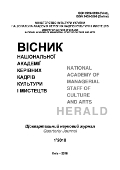VISUAL MEANS OF DESIGN AND PLASTIC MODELING
DOI:
https://doi.org/10.32461/2226-3209.1.2018.178199Анотація
Abstract. The topic of this paper is the problem of the professional design thinking formation in students
which learn such discipline as design. Design thinking is a specific spatial-figurative thinking that allows designers to materialize their ideas and designs. Design thinking allows new forms and solutions of design problems to search and find. A creative search for a designer is based on empathy, which is an understanding and emotional experience concerning a practical problem being solved. Means of formation of design thinking are graphic and layout spatial modeling. They are used in conceptual, logical and physical modeling. They are implemented in the form of a two-dimensional graphic sketch and three-dimensional layout. The iteration method allows them to gradually narrow the
search for the optimal form in the design, returning from a three-dimensional model to a planar one (for example, as a photo), and make adjustments to the final three-dimensional model layout based on the analysis. To create a design object, it is necessary to have professional skills in both plane-graphic and three-dimensional space modeling. The extrapolation of planar approaches to three-dimensional once and vice versa is productive. Both methods of modeling serve a consistent approximation to the solution of a problem. They can complement each other at different stages of designing, bringing the designer closer to the embodiment in the material of the created object. The layout allows them
to define and refine the design and proportional ratios of the parts of the object being created, its functional and aesthetic characteristics. The graphic sketch makes it possible to capture the emotionally significant characteristics of the designed object, simultaneously fix its role in various contexts of the environment, and capture the intermediate stages of creative search.
Keywords: two-dimensional graphic modeling in design, model-plastic modeling in design, iteration in design,
design thinking, designing.
Посилання
D. F.Lauer, S. Pentak, «Design Basics», Wadsworth Publishing, 303 p., 2012.
V.F. Runge, “The History of Design, Science and Technology”, Book 2, Moscow: Architecture, 430 p., 2007.
B. Martin, B. Hanington, B. M. Hanington, «Universal Methods of Design: 100 Ways to Research Complex Problems,
Develop Innovative Ideas, and Design Effective Solutions», Rockport Publishers, 207p., 2012.
W. Lidwell, K. Holden, J. Butler, «Universal Principles of Design», Rockport Publishers, 272 p., 2003.
G.R. Ahmetshina, L. H., Kadyjrova, K. I. Musina, «The use of virtual reconstruction technology to prepare intending
designers in Kazan federal university», The Turkish Online Journal of Design, Art and Communication – TOJDAC, November,
Special Edition, pp. 3131-3140, 2016.
R. Morris, The Fudamentals of product Design, 184 p., 2009.
T. Samara, Design Evolution: Theory into Practice, Rockport Publishers, Inc. 271 p., 2009.
Ch. Fiell, P. Fiell, “The Story of Design Hardcover”, Carlton Publishing Group, 512 p., 2013.
Ph. Wilkinson, “Great Design”, Dorling Kindersley, 256 p., 2013.
J. Liedtka, T. Ogilvie «Designing for Growth: A Design Thinking Toolkit for Managers», Columbia University Press,
р., 2011.
N.P. Pomortseva, E.V. Gabdrakhmanova, “Gifted Education in the Republic of Tatarstan: New Challenges and
Innovative Decisions”, Journal of Sustainable Development, Vol.8, No.5., Pp. 218-224., 2015.
E. Gabdrakhmanova, T. Rusakova, T. Morozova, R. Salahov, “Role of the System of Values of Design Studies
Graduates in Preparation for Educational Work”, INTED Proceedings, Pp. 8367-8374, 2016.
E. Gabdrakhmanova, T. Rusakova, T. Morozova, “Training Design Studies Graduates to Deal with Professional
Matters: Case-Study of A Competency-Based Approach”, INTED Proceedings., Pp. 8353-8360, 2016.
##submission.downloads##
Номер
Розділ
Ліцензія
Автори, які публікуються у цьому журналі, погоджуються з наступними умовами:
1. Автори залишають за собою право на авторство своєї роботи та передають журналу право першої публікації цієї роботи на умовах ліцензії Creative Commons Attribution License, котра дозволяє іншим особам вільно розповсюджувати опубліковану роботу з обов'язковим посиланням на авторів оригінальної роботи та першу публікацію роботи у цьому журналі.
2. Автори мають право укладати самостійні додаткові угоди щодо неексклюзивного розповсюдження роботи у тому вигляді, в якому вона була опублікована цим журналом (наприклад, розміщувати роботу в електронному сховищі установи або публікувати у складі монографії), за умови збереження посилання на першу публікацію роботи у цьому журналі.
3.Політика журналу дозволяє і заохочує розміщення авторами в мережі Інтернет (наприклад, у сховищах установ або на особистих веб-сайтах) рукопису роботи, як до подання цього рукопису до редакції, так і під час його редакційного опрацювання, оскільки це сприяє виникненню продуктивної наукової дискусії та позитивно позначається на оперативності та динаміці цитування опублікованої роботи.

